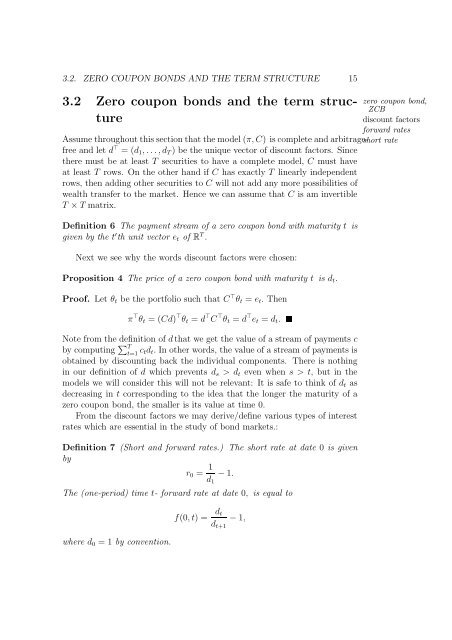Lecture Notes for Finance 1 (and More).
Lecture Notes for Finance 1 (and More).
Lecture Notes for Finance 1 (and More).
You also want an ePaper? Increase the reach of your titles
YUMPU automatically turns print PDFs into web optimized ePapers that Google loves.
3.2. ZERO COUPON BONDS AND THE TERM STRUCTURE 15<br />
3.2 Zero coupon bonds <strong>and</strong> the term structure<br />
Assume throughout this section that the model (π, C) is complete <strong>and</strong> arbitrage-<br />
free <strong>and</strong> let d ⊤ = (d1, . . ., dT) be the unique vector of discount factors. Since<br />
there must be at least T securities to have a complete model, C must have<br />
at least T rows. On the other h<strong>and</strong> if C has exactly T linearly independent<br />
rows, then adding other securities to C will not add any more possibilities of<br />
wealth transfer to the market. Hence we can assume that C is am invertible<br />
T × T matrix.<br />
Definition 6 The payment stream of a zero coupon bond with maturity t is<br />
given by the t ′ th unit vector et of R T .<br />
Next we see why the words discount factors were chosen:<br />
Proposition 4 The price of a zero coupon bond with maturity t is dt.<br />
Proof. Let θt be the portfolio such that C ⊤ θt = et. Then<br />
π ⊤ θt = (Cd) ⊤ θt = d ⊤ C ⊤ θt = d ⊤ et = dt.<br />
Note from the definition of d that we get the value of a stream of payments c<br />
by computing �T t=1 ctdt. In other words, the value of a stream of payments is<br />
obtained by discounting back the individual components. There is nothing<br />
in our definition of d which prevents ds > dt even when s > t, but in the<br />
models we will consider this will not be relevant: It is safe to think of dt as<br />
decreasing in t corresponding to the idea that the longer the maturity of a<br />
zero coupon bond, the smaller is its value at time 0.<br />
From the discount factors we may derive/define various types of interest<br />
rates which are essential in the study of bond markets.:<br />
Definition 7 (Short <strong>and</strong> <strong>for</strong>ward rates.) The short rate at date 0 is given<br />
by<br />
r0 = 1<br />
− 1.<br />
The (one-period) time t- <strong>for</strong>ward rate at date 0, is equal to<br />
where d0 = 1 by convention.<br />
d1<br />
f(0, t) = dt<br />
dt+1<br />
− 1,<br />
zero coupon bond,<br />
ZCB<br />
discount factors<br />
<strong>for</strong>ward rates<br />
short rate

















